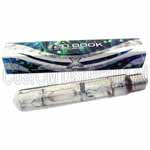XM 400 Watt 10,000K Mogul Base MH Bulb.
Product #LT-XM400-D
Availability: In stock
Description:
XM 400 Watt 10,000K Mogul Base MH Bulb.
Brand: XM
Brand: XM
Product Information
XM 400 Watt 10,000K Mogul Base MH Bulb.
The XM 10,000K is crisp white in color and is designed to simulate sunlight at shallow depths in the ocean. XM 10,000K lamps have the highest average par rating of any lamp on the market today.
When XM Lighting began in 2003, they took the hobby by storm with high PAR levels, high quality of lamps and world class customer service. They quickly became the hottest selling lamp in the hobby. They have continued the trend by developing new lamp wattages and color temperatures to meet the changing demands of the hobby.
FAQ
What is XM lamp life?
Lamp life varies depending on various operating conditions. Some key variables are lamp operating positions, duty cycle, line voltage regulation and ballasts operating characteristics.
Rated life is a statistical mean life.
XM400W is rated 6,000 hours based on 10 hours on 1 hour off duty cycle.
Shorter duty cycle will affect lamp life and performance.
Economic Life:
Economic life refers to the hours of operation during which a lamp is designed to provide optimum light output and color quality as well as lowest replacement cost. Economic life describes actual lamp life better than rated life because rated life does not account for the lumen depreciation and color shift that occur as lamps age. The economic life of lamps is generally 60% to 70% of the lamp rated life.
Rated Life:
Rated, or average (median), life for metal halide lamps is a value of lamp life expectancy based on laboratory and field tests of representative lamps, operating on approved ballasts, with a burn cycle of at least 10 hours per start. The average life is determined when 50% of traditional metal halide lamps initially installed are still operating.
What type of ballast is recommended for XM lamps?
400W Mogul Base Bulbs should use a 400W ANSI M59 rated ballast.
What is the burn in period for XM lamps?
Recommended time for lamp seasoning is 100 hours this is the recommended time per IESNA standard LM 54 91. Seasoning of the lamp will allow time related changes in the colorimetric, and/or electrical characteristics to become stable. The greatest rate of change in the operating characteristics of a MH lamp generally occur during the first hours of operation.
- Weight: 0.75 lb
- Height: 14 in
- Width: 2 in
- Depth: 2 in
LT-XM400-D
Product Rating
- No reviews for this product have been submitted
Related Products
400 watt Reeflux 10,000k MH Bulb, Coral Vue
List Price: $108.74
Our Price: $72.49
(save $36.25, 33%)
Our Price: $72.49
(save $36.25, 33%)
400 watt 10k True Metal Halide Bulb, Hamilton
List Price: $115.49
Our Price: $76.99
(save $38.5, 33%)
Our Price: $76.99
(save $38.5, 33%)
400 watt Electronic Metal Hallide Ballast, IceCap
List Price: $296.99
Our Price: $197.99
(save $99, 33%)
Our Price: $197.99
(save $99, 33%)





 Larger View
Larger View









